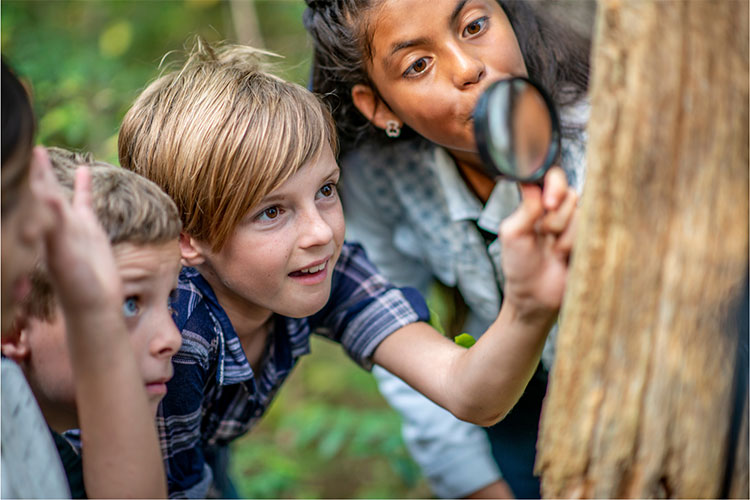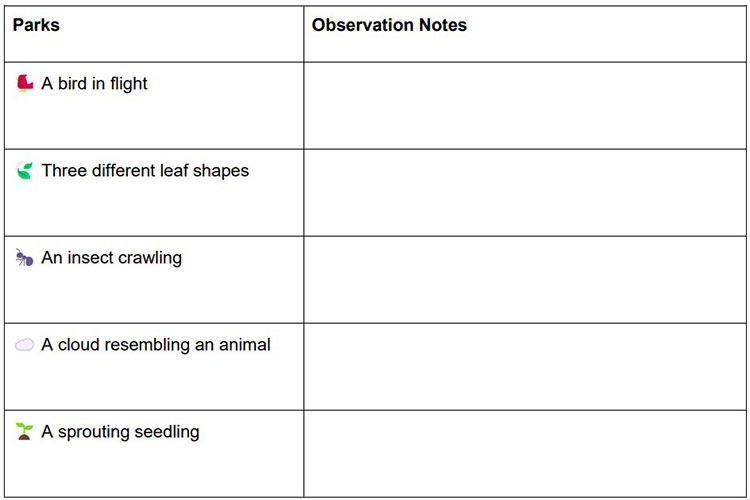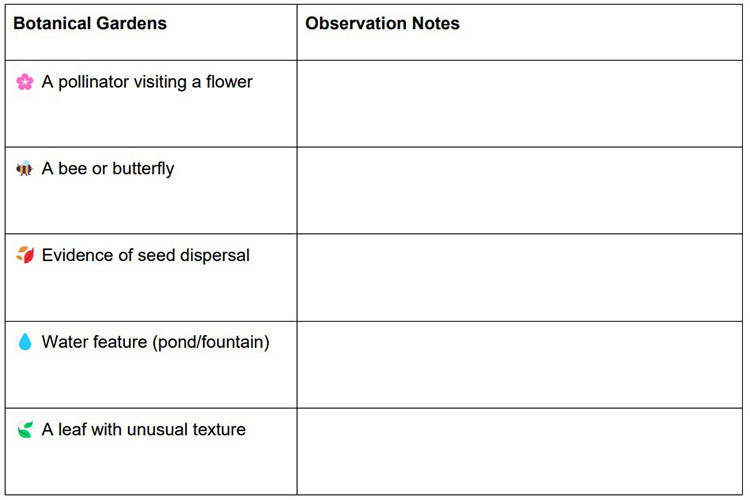Secure your Child's Spot in our Summer Camps! Click here!

What we're talking about!
Check back often for updates!
Turning Every Park Visit into a Hands-On Science Adventure for the Whole Family.
Click to Download the Scavenger Checklists Here

Spring is the perfect season to move lessons out of the classroom and into the great outdoors. At PopSmart Academy, we know that curiosity blossoms when children explore real‑world environments - so we’ve created this Family Field Trip Guide to help you discover local parks, botanical gardens, and outdoor museums in your community. Each destination includes a printable scavenger checklist and thought‑provoking discussion questions to transform a simple outing into a rich learning adventure.
Why Nature? Why Now?
Nature is the ultimate classroom, offering a wealth of opportunities for exploration, discovery, and learning. From observing insect life cycles to understanding plant ecosystems, the natural world ignites curiosity and fosters a deeper appreciation for science and the environment. And with spring's vibrant blooms and renewed energy, it's the perfect time to venture out!
Local Nature Excursion Picks
Ready for adventure? We've hand-picked three types of local destinations that offer a perfect blend of fun and learning. Each location comes with a unique focus, a kid-friendly scavenger checklist, and thought-provoking discussion questions to turn your outing into an educational experience.
Neighborhood Parks
Scavenger Checklist: Print and bring this simple checklist on your next outing. Check off items as you find them!

Discussion Questions: Use these prompts to spark deeper conversation before, during, and after your trip:
Botanical Gardens
Scavenger Checklist: Print and bring this simple checklist on your next outing. Check off items as you find them!

Discussion Questions: Use these prompts to spark deeper conversation before, during, and after your trip:
Outdoor Museums & Nature Centers
Scavenger Checklist: Print and bring this simple checklist on your next outing. Check off items as you find them!

Discussion Questions: Use these prompts to spark deeper conversation before, during, and after your trip:
Extend the Learning
After your adventure, turn observations into projects that reinforce critical thinking:
Field Trip Prep & Safety Tips
Before you head out, I want to remind you of some preparatory and safety tips.
These family field trips offer a fantastic opportunity to combine outdoor adventure with hands-on learning. So, pack your bags, lace up your hiking boots, and get ready to explore the wonders of nature with your kids!
Ready to unleash your child's inner creator and innovator? Explore our programs and discover how PopSmart Academy can help your child reach their full potential. Book a FREE trial class here.
Spring is the perfect season to move lessons out of the classroom and into the great outdoors. At PopSmart Academy, we know that curiosity blossoms when children explore real‑world environments - so we’ve created this Family Field Trip Guide to help you discover local parks, botanical gardens, and outdoor museums in your community. Each destination includes a printable scavenger checklist and thought‑provoking discussion questions to transform a simple outing into a rich learning adventure.Why Nature? Why Now?Nature is the ultimate classroom, offering a wealth of opportunities for exploration, discovery, and learning. From observing insect life cycles to understanding plant ecosystems, the natural world ignites curiosity and fosters a deeper appreciation for science and the environment. And with spring's vibrant blooms and renewed energy, it's the perfect time to venture out!Local Nature Excursion PicksReady for adventure? We've hand-picked three types of local destinations that offer a perfect blend of fun and learning. Each location comes with a unique focus, a kid-friendly scavenger checklist, and thought-provoking discussion questions to turn your outing into an educational experience.Neighborhood Parks●Parks offer accessible green space for observing ecosystems in miniature.●What to look for: trees, insects, bird species, ecosystems, animal tracks, and evidence of seasonal change.Scavenger Checklist: Print and bring this simple checklist on your next outing. Check off items as you find them!ParksObservation Notes🐦 A bird in flight🍃 Three different leaf shapes🐜 An insect crawling☁️ A cloud resembling an animal🌱 A sprouting seedling
Discussion Questions: Use these prompts to spark deeper conversation before, during, and after your trip:●What are the signs of spring you observe?●What adaptations help the plant or animal survive here?●How does weather affect this environment?●How might this ecosystem change in a month?●How do plants and animals depend on each other?●How do humans affect this ecosystem?Botanical Gardens●Gardens showcase plant diversity, pollination processes, and conservation in action. Immerse yourselves in a world of vibrant flowers, exotic plants, and diverse ecosystems.●What to look for: Flower anatomy, pollinators, and adaptations (e.g., thorns, waxy leaves).Scavenger Checklist: Print and bring this simple checklist on your next outing. Check off items as you find them!Botanical GardensObservation Notes🌸 A pollinator visiting a flower🐝 A bee or butterfly🍂 Evidence of seed dispersal💧 Water feature (pond/fountain)🍃 A leaf with unusual texture
Discussion Questions: Use these prompts to spark deeper conversation before, during, and after your trip:●How do flowers attract pollinators?●What role do humans play in plant conservation?●Why might different plants live in separate garden zones?●How do plants get their food?●What are the different parts of a flower?●Why are pollinators important?Outdoor Museums & Nature Centers●These venues blend interactive exhibits with hands-on trails—perfect for guided inquiry. Engage with interactive exhibits and learn about local wildlife and environmental conservation.●What to look for: Interpretive signage, interactive displays, and curated habitats.Scavenger Checklist: Print and bring this simple checklist on your next outing. Check off items as you find them!Outdoor MuseumsObservation Notes🪨 A labeled rock specimen📜 An informational sign about local wildlife🔍 A magnifying glass station🦋 Live animal enclosure🌳 A tree with interpretive plaque
Discussion Questions: Use these prompts to spark deeper conversation before, during, and after your trip:●Why is preserving local habitats important?●What can we learn from fossils or geological displays?●How do interactive exhibits help us understand science?●How can we protect our local environment?●What are the challenges facing local wildlife?●What can we do to reduce our environmental impact?Extend the LearningAfter your adventure, turn observations into projects that reinforce critical thinking:●Create a Nature Journal: Encourage your child to document their observations and reflections in a journal. Sketch discoveries, jot questions, and note weather conditions.●Conduct Research: After your trip, research the plants and animals you encountered. Pick one scavenger‑hunt find and learn more online—present findings to family.●Create Art Inspired by Nature: Use natural materials or create drawings and paintings inspired by your experience. You can also create a “Then & Now” spring‑growth timeline.●Plant a Garden: Start a small garden at home to learn about plant growth and care.Field Trip Prep & Safety TipsBefore you head out I want to remind you of some preparatory and safety tips.●Pack smart: Water, snacks, sunscreen, hats, and hand sanitizer.●Dress for success: Closed‑toe shoes, layers, and weather‑appropriate gear.●Set expectations: Review the scavenger list together and assign roles (navigator, note‑taker, photographer).●Stay curious—but safe: Respect wildlife, stick to trails, and keep hands clean.●Bring these observation tools: a magnifying lens, ziplock bags for collecting rock, soil, or plant samples, and small boxes for water samples.These family field trips offer a fantastic opportunity to combine outdoor adventure with hands-on learning. So, pack your bags, lace up your hiking boots, and get ready to explore the wonders of nature with your kids!
—-----------------------------------------—-----------------------------------------—------------------Ready to unleash your child's inner creator and innovator? Explore our programs and discover how PopSmart Academy can help your child reach their full potential. Book a FREE trial class here.
Help your kids fall in love with reading!
Need a list of amazing books to get your kids inspired about writing their own stories?
Grab your free copy by completing the form.
We'll email you the ebook!